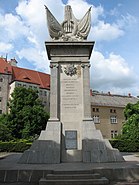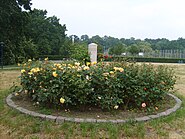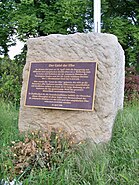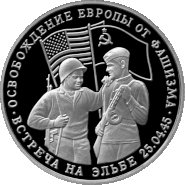
In an arranged photo commemorating the meeting of the Soviet and American armies, 2nd Lt. William Robertson (U.S. Army) and Lt. Alexander Silvashko (Red Army) stand facing one another with hands clasped and arms around each other's shoulders. In the background are two flags and a poster.
Elbe Day, April 25, 1945, is the day Soviet and American troops met at the River Elbe, near Torgau in Germany, marking an important step toward the end of World War II in Europe. This contact between the Soviets, advancing from the East, and the Americans, advancing from the West, meant that the two powers had effectively cut Germany in two. Elbe Day has never been an official holiday in any country, but in the years after 1945 the memory of this friendly encounter gained new significance in the context of the Cold War between the U.S. and the Soviet Union.
History[]
The first contact between American and Soviet patrols occurred near Strehla, after First Lieutenant Albert Kotzebue, an American soldier, crossed the River Elbe in a boat with three men of an intelligence and reconnaissance platoon. On the east bank they met forward elements of a Soviet Guards rifle regiment of the First Ukrainian Front, under the command of Lieutenant Colonel Alexander Gardiev. The same day, another patrol under Second Lieutenant William Robertson with Frank Huff, James McDonnell and Paul Staub met a Soviet patrol commanded by Lieutenant Alexander Silvashko on the destroyed Elbe bridge of Torgau.[1]
On April 26, the commanders of the 69th Infantry Division of the First Army and the 58th Guards Rifle Division of the 5th Guards Army (Soviet Union) met at Torgau, southwest of Berlin. Arrangements were made for the formal "Handshake of Torgau" between Robertson and Silvashko in front of photographers the following day, April 27. The Soviet, American, and British governments released simultaneous statements that evening in London, Moscow, and Washington, reaffirming the determination of the three Allied powers to complete the destruction of the Third Reich.
Commemorations[]
Monuments at Torgau, Lorenzkirch, and Bad Liebenwerda commemorate the first encounters between U.S. and Soviet troops on Elbe Day. In the United States, a "Spirit of the Elbe" plaque at Arlington National Cemetery commemorates the day.
In 1949 the Russian film studio Mosfilm commemorated Elbe Day in the black-and-white film Encounter at the Elbe.
During the Cold War the meeting of the two armies was often recalled as a symbol of peace and friendship between the people of the two antagonistic superpowers. For example, in 1961 the popular Russian song "Do the Russians Want War?" evoked the memory of American and Russian soldiers embracing at the Elbe River.
Joseph Polowsky, an American soldier who met Soviet troops on Elbe Day, was deeply affected by the experience and devoted much of his life to opposing war. He commemorated Elbe Day each year in his hometown of Chicago and unsuccessfully petitioned the United Nations to make April 25 a "World Day of Peace." His remains are buried in a cemetery in Torgau.
American singer-songwriter Fred Small commemorated Joseph Polowsky and Elbe Day in his song "At The Elbe".
In 1988 a plaque titled "Der Geist der Elbe" ("Spirit of the Elbe") was mounted on a stone near Torgau at the site of the encounter between troops of the U.S. 69th Infentry and the Soviet Guards. In 1995 the Russian Federation issued a three-ruble coin commemorating the 50th anniversary of Elbe Day.[2]
By 2010, the 65th anniversary of the event, Elbe Day events in Torgau were held annually on the weekend closest to April 25, attracting tourists to the city.[3] Also in 2010, the U.S. and Russian presidents for the first time issued a joint statement on April 25 commemorating Elbe Day and the "spirit of the Elbe".[4][5]
The meeting at the Elbe is represented in the war strategy game R.U.S.E., released in 2010 and 2011 and based loosely on World War II events.
See also[]
Citations[]
- ↑ Time Magazine
- ↑ "Victory!". Russia at War 1941 - 1945. http://www.great-victory1945.ru/victory.htm. Retrieved 2013-06-15.
- ↑ Vetter, Rene (2010). "Elbe Day - english". http://www.torgau.eu/p/d2.asp?artikel_id=1170&liste=&tmpl_typ=Detail&l=1. Retrieved June 15, 2013.
- ↑ "Russian and U.S. presidents issue statement marking Elbe Day 65th anniversary". RIA Novosti. 2010-04-25. http://en.rian.ru/world/20100425/158739867.html. Retrieved 2013-06-15.
- ↑ Xuequan, Mu (2010-04-26). "Medvedev, Obama issue joint statement marking 65th Elbe Day anniversary". English.news.cn. Xinhua News Agency.
External links[]
| Wikimedia Commons has media related to Elbe Day. |
- First contact of Robertson and Silvashko on the destroyed Elbe bridge of Torgau.
- The War is Over - American and Russian troops meet at the Elbe, A People At War, U.S. National Archives and Records Administration
- Nora FitzGerald, Elbe Day commemorated 26 April 2010, Russia Beyond the Headlines, article with photos slideshow.
- East Germany Elbe Meeting - Time Magazine, May 6, 1985
- "Remembering War" simulcast between US and USSR / SATELLITE LINKUP TO REUNITE SOVIET AND AMERICAN WW II VETS - UCSD press release April 29, 1985
The original article can be found at Elbe Day and the edit history here.







